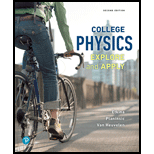
Concept explainers
BIO Muscles work in pairs Skeletal muscles produce movements by pulling on tendons, which in turn pull on bones. Usually, a muscle is attached to two bones via a tendon on each end of the muscle. When the muscle contracts, it moves one bone toward the other. The other bone remains in nearly the original position. The point where a muscle tendon is attached to the stationary bone is called the origin. The point where the other muscle tendon is attached to the movable bone is called the insertion. The origin is like the part of a door spring that is attached to the doorframe. The insertion is similar to the part of the spring that is attached to the movable door.
During movement, bones act as levers and joints act as axes of rotation for these levers. Most movements require several skeletal muscles working in groups, because a muscle can only exert a pull and not a push. In addition, most skeletal muscles are arranged in opposing pairs at joints. Muscles that bring two limbs together are called flexor muscles (such as the biceps muscle in the upper arm in Figure 8.25). Those that cause the limb to extend outward are called extensor muscles (such as the triceps muscle in the upper arm). The flexor muscle is used when you hold a heavy object in your hand; the extensor muscle can be used, for example, to extend your arm when you throw a ball.
Why are muscles arranged in pairs at joints?
a. Two muscles can produce a bigger torque than one.
b. One can produce a positive torque and the other a negative torque.
c. One muscle can pull on the bone and the other can push.
d. Both a and b are true
Want to see the full answer?
Check out a sample textbook solution
Chapter 8 Solutions
EBK COLLEGE PHYSICS
Additional Science Textbook Solutions
Fundamentals of Anatomy & Physiology (11th Edition)
Human Physiology: An Integrated Approach (8th Edition)
Genetic Analysis: An Integrated Approach (3rd Edition)
Applications and Investigations in Earth Science (9th Edition)
Chemistry: An Introduction to General, Organic, and Biological Chemistry (13th Edition)
Microbiology: An Introduction
- 8. With the aid of a diagram draw the following electric circuit and use the resistor as the load, (a) Closed circuit (b) Open circuitarrow_forwardLab 8 Part 3 PHET Wave Interface simulation. I am having trouble with this part of the lab.arrow_forwardMick and Rick are twins born on Earth in the year 2175. Rick grows up to be an Earth-bound robotics technician while Mick becomes an intergalactic astronaut. Mick leaves the Earth on his first space mission in the year 2200 and travels, according to his clock, for 10 years at a speed of 0.75c. Unfortunately, at this point in his journey, the structure of his ship undergoes mechanical breakdown and the ship explodes. How old is Rick when his brother dies?arrow_forward
 College PhysicsPhysicsISBN:9781938168000Author:Paul Peter Urone, Roger HinrichsPublisher:OpenStax College
College PhysicsPhysicsISBN:9781938168000Author:Paul Peter Urone, Roger HinrichsPublisher:OpenStax College Principles of Physics: A Calculus-Based TextPhysicsISBN:9781133104261Author:Raymond A. Serway, John W. JewettPublisher:Cengage Learning
Principles of Physics: A Calculus-Based TextPhysicsISBN:9781133104261Author:Raymond A. Serway, John W. JewettPublisher:Cengage Learning Physics for Scientists and EngineersPhysicsISBN:9781337553278Author:Raymond A. Serway, John W. JewettPublisher:Cengage Learning
Physics for Scientists and EngineersPhysicsISBN:9781337553278Author:Raymond A. Serway, John W. JewettPublisher:Cengage Learning Physics for Scientists and Engineers with Modern ...PhysicsISBN:9781337553292Author:Raymond A. Serway, John W. JewettPublisher:Cengage Learning
Physics for Scientists and Engineers with Modern ...PhysicsISBN:9781337553292Author:Raymond A. Serway, John W. JewettPublisher:Cengage Learning Physics for Scientists and Engineers, Technology ...PhysicsISBN:9781305116399Author:Raymond A. Serway, John W. JewettPublisher:Cengage Learning
Physics for Scientists and Engineers, Technology ...PhysicsISBN:9781305116399Author:Raymond A. Serway, John W. JewettPublisher:Cengage Learning College PhysicsPhysicsISBN:9781305952300Author:Raymond A. Serway, Chris VuillePublisher:Cengage Learning
College PhysicsPhysicsISBN:9781305952300Author:Raymond A. Serway, Chris VuillePublisher:Cengage Learning





